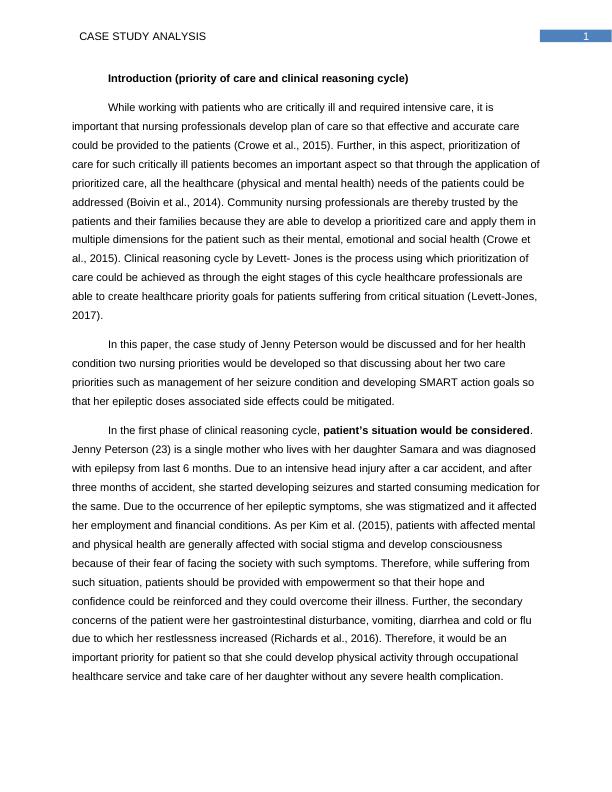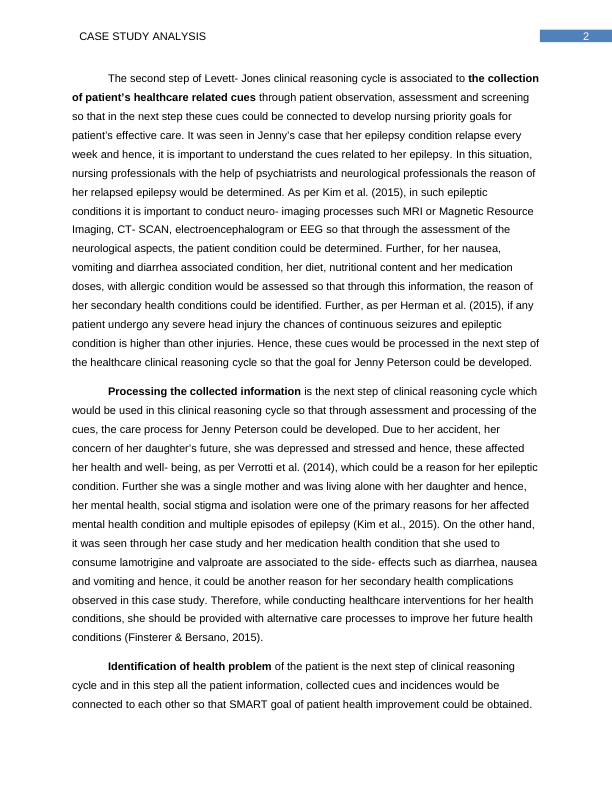Case Study Analysis: Jenny Peterson
Added on 2023-04-08
7 Pages2201 Words112 Views
Running head: CASE STUDY ANALYSIS
CASE STUDY ANALYSIS: JENNY PETERSON
Name of the student
Name of the university
Author note
CASE STUDY ANALYSIS: JENNY PETERSON
Name of the student
Name of the university
Author note

1CASE STUDY ANALYSIS
Introduction (priority of care and clinical reasoning cycle)
While working with patients who are critically ill and required intensive care, it is
important that nursing professionals develop plan of care so that effective and accurate care
could be provided to the patients (Crowe et al., 2015). Further, in this aspect, prioritization of
care for such critically ill patients becomes an important aspect so that through the application of
prioritized care, all the healthcare (physical and mental health) needs of the patients could be
addressed (Boivin et al., 2014). Community nursing professionals are thereby trusted by the
patients and their families because they are able to develop a prioritized care and apply them in
multiple dimensions for the patient such as their mental, emotional and social health (Crowe et
al., 2015). Clinical reasoning cycle by Levett- Jones is the process using which prioritization of
care could be achieved as through the eight stages of this cycle healthcare professionals are
able to create healthcare priority goals for patients suffering from critical situation (Levett-Jones,
2017).
In this paper, the case study of Jenny Peterson would be discussed and for her health
condition two nursing priorities would be developed so that discussing about her two care
priorities such as management of her seizure condition and developing SMART action goals so
that her epileptic doses associated side effects could be mitigated.
In the first phase of clinical reasoning cycle, patient’s situation would be considered.
Jenny Peterson (23) is a single mother who lives with her daughter Samara and was diagnosed
with epilepsy from last 6 months. Due to an intensive head injury after a car accident, and after
three months of accident, she started developing seizures and started consuming medication for
the same. Due to the occurrence of her epileptic symptoms, she was stigmatized and it affected
her employment and financial conditions. As per Kim et al. (2015), patients with affected mental
and physical health are generally affected with social stigma and develop consciousness
because of their fear of facing the society with such symptoms. Therefore, while suffering from
such situation, patients should be provided with empowerment so that their hope and
confidence could be reinforced and they could overcome their illness. Further, the secondary
concerns of the patient were her gastrointestinal disturbance, vomiting, diarrhea and cold or flu
due to which her restlessness increased (Richards et al., 2016). Therefore, it would be an
important priority for patient so that she could develop physical activity through occupational
healthcare service and take care of her daughter without any severe health complication.
Introduction (priority of care and clinical reasoning cycle)
While working with patients who are critically ill and required intensive care, it is
important that nursing professionals develop plan of care so that effective and accurate care
could be provided to the patients (Crowe et al., 2015). Further, in this aspect, prioritization of
care for such critically ill patients becomes an important aspect so that through the application of
prioritized care, all the healthcare (physical and mental health) needs of the patients could be
addressed (Boivin et al., 2014). Community nursing professionals are thereby trusted by the
patients and their families because they are able to develop a prioritized care and apply them in
multiple dimensions for the patient such as their mental, emotional and social health (Crowe et
al., 2015). Clinical reasoning cycle by Levett- Jones is the process using which prioritization of
care could be achieved as through the eight stages of this cycle healthcare professionals are
able to create healthcare priority goals for patients suffering from critical situation (Levett-Jones,
2017).
In this paper, the case study of Jenny Peterson would be discussed and for her health
condition two nursing priorities would be developed so that discussing about her two care
priorities such as management of her seizure condition and developing SMART action goals so
that her epileptic doses associated side effects could be mitigated.
In the first phase of clinical reasoning cycle, patient’s situation would be considered.
Jenny Peterson (23) is a single mother who lives with her daughter Samara and was diagnosed
with epilepsy from last 6 months. Due to an intensive head injury after a car accident, and after
three months of accident, she started developing seizures and started consuming medication for
the same. Due to the occurrence of her epileptic symptoms, she was stigmatized and it affected
her employment and financial conditions. As per Kim et al. (2015), patients with affected mental
and physical health are generally affected with social stigma and develop consciousness
because of their fear of facing the society with such symptoms. Therefore, while suffering from
such situation, patients should be provided with empowerment so that their hope and
confidence could be reinforced and they could overcome their illness. Further, the secondary
concerns of the patient were her gastrointestinal disturbance, vomiting, diarrhea and cold or flu
due to which her restlessness increased (Richards et al., 2016). Therefore, it would be an
important priority for patient so that she could develop physical activity through occupational
healthcare service and take care of her daughter without any severe health complication.

2CASE STUDY ANALYSIS
The second step of Levett- Jones clinical reasoning cycle is associated to the collection
of patient’s healthcare related cues through patient observation, assessment and screening
so that in the next step these cues could be connected to develop nursing priority goals for
patient’s effective care. It was seen in Jenny’s case that her epilepsy condition relapse every
week and hence, it is important to understand the cues related to her epilepsy. In this situation,
nursing professionals with the help of psychiatrists and neurological professionals the reason of
her relapsed epilepsy would be determined. As per Kim et al. (2015), in such epileptic
conditions it is important to conduct neuro- imaging processes such MRI or Magnetic Resource
Imaging, CT- SCAN, electroencephalogram or EEG so that through the assessment of the
neurological aspects, the patient condition could be determined. Further, for her nausea,
vomiting and diarrhea associated condition, her diet, nutritional content and her medication
doses, with allergic condition would be assessed so that through this information, the reason of
her secondary health conditions could be identified. Further, as per Herman et al. (2015), if any
patient undergo any severe head injury the chances of continuous seizures and epileptic
condition is higher than other injuries. Hence, these cues would be processed in the next step of
the healthcare clinical reasoning cycle so that the goal for Jenny Peterson could be developed.
Processing the collected information is the next step of clinical reasoning cycle which
would be used in this clinical reasoning cycle so that through assessment and processing of the
cues, the care process for Jenny Peterson could be developed. Due to her accident, her
concern of her daughter’s future, she was depressed and stressed and hence, these affected
her health and well- being, as per Verrotti et al. (2014), which could be a reason for her epileptic
condition. Further she was a single mother and was living alone with her daughter and hence,
her mental health, social stigma and isolation were one of the primary reasons for her affected
mental health condition and multiple episodes of epilepsy (Kim et al., 2015). On the other hand,
it was seen through her case study and her medication health condition that she used to
consume lamotrigine and valproate are associated to the side- effects such as diarrhea, nausea
and vomiting and hence, it could be another reason for her secondary health complications
observed in this case study. Therefore, while conducting healthcare interventions for her health
conditions, she should be provided with alternative care processes to improve her future health
conditions (Finsterer & Bersano, 2015).
Identification of health problem of the patient is the next step of clinical reasoning
cycle and in this step all the patient information, collected cues and incidences would be
connected to each other so that SMART goal of patient health improvement could be obtained.
The second step of Levett- Jones clinical reasoning cycle is associated to the collection
of patient’s healthcare related cues through patient observation, assessment and screening
so that in the next step these cues could be connected to develop nursing priority goals for
patient’s effective care. It was seen in Jenny’s case that her epilepsy condition relapse every
week and hence, it is important to understand the cues related to her epilepsy. In this situation,
nursing professionals with the help of psychiatrists and neurological professionals the reason of
her relapsed epilepsy would be determined. As per Kim et al. (2015), in such epileptic
conditions it is important to conduct neuro- imaging processes such MRI or Magnetic Resource
Imaging, CT- SCAN, electroencephalogram or EEG so that through the assessment of the
neurological aspects, the patient condition could be determined. Further, for her nausea,
vomiting and diarrhea associated condition, her diet, nutritional content and her medication
doses, with allergic condition would be assessed so that through this information, the reason of
her secondary health conditions could be identified. Further, as per Herman et al. (2015), if any
patient undergo any severe head injury the chances of continuous seizures and epileptic
condition is higher than other injuries. Hence, these cues would be processed in the next step of
the healthcare clinical reasoning cycle so that the goal for Jenny Peterson could be developed.
Processing the collected information is the next step of clinical reasoning cycle which
would be used in this clinical reasoning cycle so that through assessment and processing of the
cues, the care process for Jenny Peterson could be developed. Due to her accident, her
concern of her daughter’s future, she was depressed and stressed and hence, these affected
her health and well- being, as per Verrotti et al. (2014), which could be a reason for her epileptic
condition. Further she was a single mother and was living alone with her daughter and hence,
her mental health, social stigma and isolation were one of the primary reasons for her affected
mental health condition and multiple episodes of epilepsy (Kim et al., 2015). On the other hand,
it was seen through her case study and her medication health condition that she used to
consume lamotrigine and valproate are associated to the side- effects such as diarrhea, nausea
and vomiting and hence, it could be another reason for her secondary health complications
observed in this case study. Therefore, while conducting healthcare interventions for her health
conditions, she should be provided with alternative care processes to improve her future health
conditions (Finsterer & Bersano, 2015).
Identification of health problem of the patient is the next step of clinical reasoning
cycle and in this step all the patient information, collected cues and incidences would be
connected to each other so that SMART goal of patient health improvement could be obtained.

End of preview
Want to access all the pages? Upload your documents or become a member.
Related Documents
Clinical Reasoning Cycle: Nursing Case Study Analysislg...
|7
|2699
|94
Role of Community Nurse in Managing a Nursing Case Studylg...
|9
|2392
|437
The Role of a Primary Health Care Nurse in Managing Epilepsy: A Case Studylg...
|6
|2274
|76
Nursing Priorities in Chronic Diseaselg...
|7
|2523
|286
Nursing Assignment: Case Study Analysis (Marcel)lg...
|8
|1980
|438
Assessment of Patient Jenny Peterson: Maintaining a Safe Environment and Deficient Knowledge on Seizure Managementlg...
|6
|2184
|439
